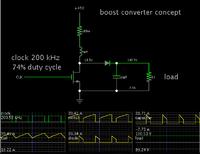Jay R
Newbie level 5
hi,
I need to design and build a boost circuit for my school project and all I am given is the following specifications:
Voltage in is 45v to 75v
voltage out is 100v (eventually they want 150v)
the power is 800w
and the current is 8amps
the switching frequency is 200 kHz
and the efficiency is >=90 %
any help with this would be greately appreciated.
- - - Updated - - -
sorry the output current is 8 amps
I need to design and build a boost circuit for my school project and all I am given is the following specifications:
Voltage in is 45v to 75v
voltage out is 100v (eventually they want 150v)
the power is 800w
and the current is 8amps
the switching frequency is 200 kHz
and the efficiency is >=90 %
any help with this would be greately appreciated.
- - - Updated - - -
sorry the output current is 8 amps
